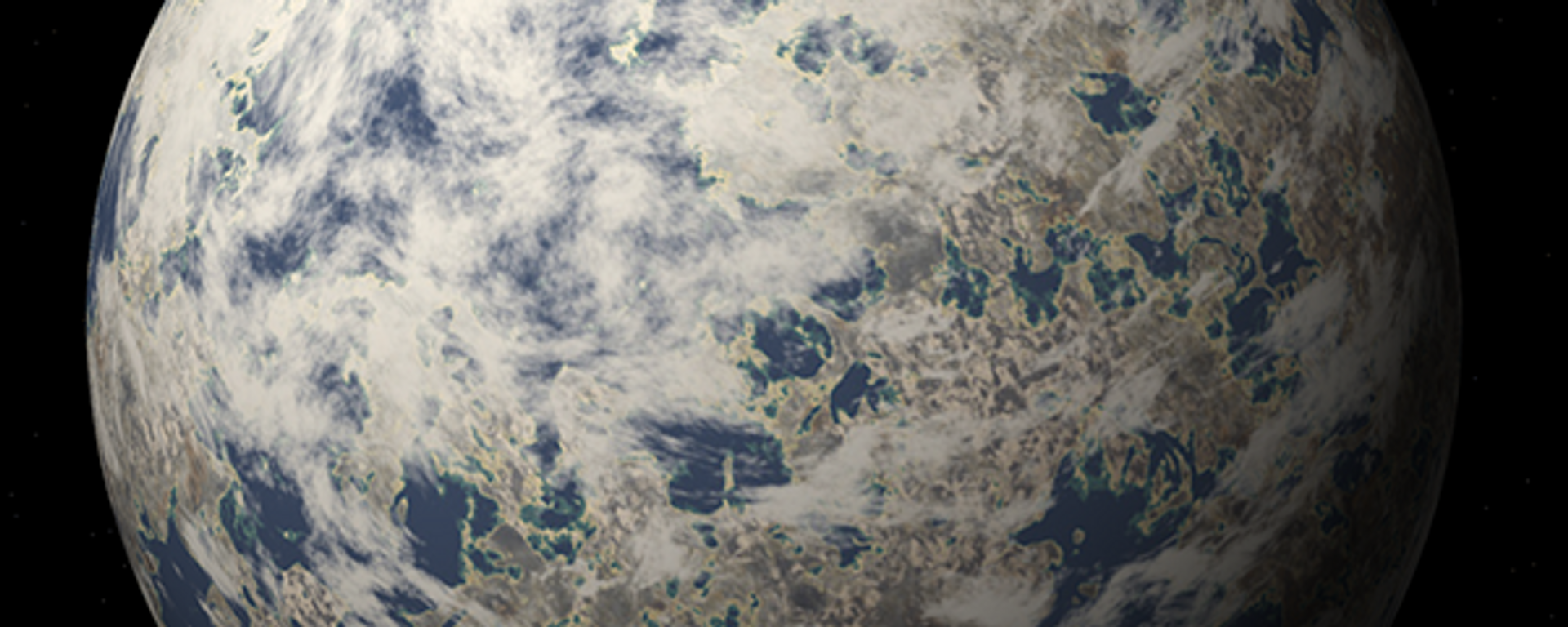https://sputnikglobe.com/20220823/star-wars-scientists-battle-over-webb-space-telescope-debunking-big-bang-theory--1099888384.html
Star Wars: Scientists Battle Over Webb Space Telescope 'Debunking' Big Bang Theory
Star Wars: Scientists Battle Over Webb Space Telescope 'Debunking' Big Bang Theory
Sputnik International
The theory that all matter was condensed in a hot mass nearly 14 billion years ago before exploding outwards has faced technical obstacles in the past... 23.08.2022, Sputnik International
2022-08-23T12:26+0000
2022-08-23T12:26+0000
2023-04-21T10:42+0000
big bang
big bang theory
james webb space telescope (jwst)
science & tech
https://cdn1.img.sputnikglobe.com/img/07e6/08/17/1099888502_0:219:1000:782_1920x0_80_0_0_b51b2f75c18a959d05d9444a5e4fd417.jpg
Science writers have rushed to downplay evidence in images from NASA's new space telescope that call the "Big Bang" theory into question.The James Webb Space Telescope (JWST), which began its mission of imaging the cosmos in July this year, has already produced astounding images.But just as Galileo Galilei's first telescope helped overturn medieval concepts of cosmology, the JWST has also observed very distant galaxies that appear to be older than the theorized birth date of the universe.Pre-review study server arXiv received a flurry of papers highlighting the extreme age of those celestial bodies — without explicitly making the deduction that the Big Bang theory was wrong.If those galaxies, whose light has taken 13.5 billion years to reach Earth, were all small then the theory would be safe and sound. But some of them appear to be massive, indicating they were already ancient at a time when some physicists argue the first stars had yet to be formed.Ellis also tried to downplay the data, saying: "It’s one thing to put a paper on arXiv, but it’s quite something else to turn it into a lasting article in a peer-reviewed journal."The 90-year-old theory that the universe began in a "hot, dense state" nearly 14 billion years ago before rapidly expanding in the biggest explosion ever has captured imaginations — and lent its name to the popular US sitcom.The theory helps explain the apparent bubble-like shape of the observable universe as constantly expanding from a central point, along with other phenomena such as the cosmic microwave background. It characterizes the birth explosion not as matter expanding into existing space, but the expansion of space itself from an almost infinitesimal point to its current huge expanse.Crucially, after the first burst of energy, the universe entered a "cosmic dark age" of utter blackness until the first stars coalesced from clouds of matter hundreds of millions of years later. But NASA itself pointed out that the theory was in "crisis" due to difficulties in calculating the expansion rate and therefore the age of the universe. Some estimates put it as low as 9 billion years — younger than the apparent age of some stars.That was until measurements of background cosmic radiation by the Wilkinson Microwave Anisotropy Probe (WMAP) satellite to within a 1.5 percent margin pinned the figure down to 13.77 billion years, give or take 60 million.Tech news website CNET rushed to debunk the debunking of the cherished theory. Its science editor Jackson Ryan claimed the story began with an August 11 article by veteran dissident physicist Eric J. Lerner — author of the 1992 book The Big Bang Never Happened. Ryan accused Lerner of quoting University of Kansas astronomer Allison Kirkpatrick out of context when she said: "Right now I find myself lying awake at three in the morning and wondering if everything I've done is wrong."But the Sky and Telescope article predates Lerner's by a day, and does not mention the Big Bang skeptic at all."In the flood of technical astronomical papers published online since July 12, the authors report again and again that the images show surprisingly many galaxies, galaxies that are surprisingly smooth, surprisingly small and surprisingly old. Lots of surprises, and not necessarily pleasant ones."
https://sputnikglobe.com/20220806/james-webb-space-telescope-to-ascertain-potential-habitability-of-trappist-1-worlds-1099339200.html
Sputnik International
feedback@sputniknews.com
+74956456601
MIA „Rossiya Segodnya“
2022
James Tweedie
https://cdn1.img.sputnikglobe.com/img/07e4/08/1c/1080307270_0:3:397:400_100x100_80_0_0_7777393b9b18802f2e3c5eaa9cbcc612.png
James Tweedie
https://cdn1.img.sputnikglobe.com/img/07e4/08/1c/1080307270_0:3:397:400_100x100_80_0_0_7777393b9b18802f2e3c5eaa9cbcc612.png
News
en_EN
Sputnik International
feedback@sputniknews.com
+74956456601
MIA „Rossiya Segodnya“
Sputnik International
feedback@sputniknews.com
+74956456601
MIA „Rossiya Segodnya“
James Tweedie
https://cdn1.img.sputnikglobe.com/img/07e4/08/1c/1080307270_0:3:397:400_100x100_80_0_0_7777393b9b18802f2e3c5eaa9cbcc612.png
big bang, big bang theory, james webb space telescope (jwst), science & tech
big bang, big bang theory, james webb space telescope (jwst), science & tech
Star Wars: Scientists Battle Over Webb Space Telescope 'Debunking' Big Bang Theory
12:26 GMT 23.08.2022 (Updated: 10:42 GMT 21.04.2023) The theory that all matter was condensed in a hot mass nearly 14 billion years ago before exploding outwards has faced technical obstacles in the past, including uncertainties about how fast the universe has been expanding since the “Big Bang” — and whether that dates the event as younger than some stars.
Science writers have rushed to downplay evidence in images from
NASA's new space telescope that call the "Big Bang" theory into question.
The
James Webb Space Telescope (JWST), which began its mission of imaging the cosmos in July this year, has already produced astounding images.
But just as Galileo Galilei's first telescope helped overturn medieval concepts of cosmology, the JWST has also observed very distant galaxies that appear to be older than the theorized birth date of the universe.
"It worries me slightly that we find these monsters in the first few images,"
Sky and Telescope quoted University College London astrophysics Professor Richard Ellis as saying earlier this month.
Pre-review study server arXiv received a flurry of papers highlighting the extreme age of those celestial bodies — without explicitly making the deduction that the Big Bang theory was wrong.
If those galaxies, whose light has taken 13.5 billion years to reach Earth, were all small then the theory would be safe and sound. But some of them appear to be massive, indicating they were already ancient at a time when some physicists argue the
first stars had yet to be formed.
"I’m sure some of them will be [confirmed], but I’m equally sure they won’t all be," European Space Agency senior advisor Mark McCaughrean tweeted. "It does all feel a little like a sugar rush at the moment," he cautioned.
Ellis also tried to downplay the data, saying: "It’s one thing to put a paper on arXiv, but it’s quite something else to turn it into a lasting article in a peer-reviewed journal."
The 90-year-old theory that the universe began in a "hot, dense state" nearly 14 billion years ago before rapidly expanding in the biggest explosion ever has captured imaginations — and lent its name to the popular
US sitcom.
The theory helps explain the apparent bubble-like shape of the observable universe as constantly expanding from a central point, along with other phenomena such as the cosmic microwave background. It characterizes the birth explosion not as matter expanding into existing space, but the expansion of space itself from an almost infinitesimal point to its current huge expanse.
Crucially, after the first burst of energy, the universe entered a "cosmic dark age" of utter blackness until the first stars coalesced from clouds of matter hundreds of millions of years later.
But NASA itself
pointed out that the theory was in "crisis" due to difficulties in calculating the expansion rate and therefore the age of the universe. Some estimates put it as low as 9 billion years — younger than the apparent age of some stars.
That was until measurements of background cosmic radiation by the Wilkinson Microwave Anisotropy Probe (WMAP) satellite to within a 1.5 percent margin pinned the figure down to 13.77 billion years, give or take 60 million.
Tech news website
CNET rushed to debunk the debunking of the cherished theory. Its science editor Jackson Ryan claimed the story began with an
August 11 article by veteran dissident physicist Eric J. Lerner — author of the 1992 book
The Big Bang Never Happened. Ryan accused Lerner of quoting University of Kansas astronomer Allison Kirkpatrick out of context when she said: "Right now I find myself lying awake at three in the morning and wondering if everything I've done is wrong."
But the Sky and Telescope article predates Lerner's by a day, and does not mention the Big Bang skeptic at all.
"To everyone who sees them, the new James Webb Space Telescope (JWST) images of the cosmos are beautifully awe-inspiring," Lerner wrote. "But to most professional astronomers and cosmologists, they are also extremely surprising — not at all what was predicted by theory."
"In the flood of technical astronomical papers published online since July 12, the authors report again and again that the images show surprisingly many galaxies, galaxies that are surprisingly smooth, surprisingly small and surprisingly old. Lots of surprises, and not necessarily pleasant ones."



